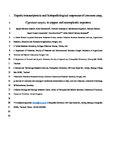Hepatic transcriptomic and histopathological responses of common carp, Cyprinus carpio, to copper and microplastic exposure
| dc.contributor.author | Hoseini, SM | |
| dc.contributor.author | Khosraviani, K | |
| dc.contributor.author | Hosseinpour Delavar, F | |
| dc.contributor.author | Arghideh, M | |
| dc.contributor.author | Zavvar, F | |
| dc.contributor.author | Hoseinifar, SH | |
| dc.contributor.author | Van Doan, H | |
| dc.contributor.author | Zabihi, E | |
| dc.contributor.author | Reverter, Miriam | |
| dc.date.accessioned | 2022-02-10T22:37:28Z | |
| dc.date.available | 2022-02-10T22:37:28Z | |
| dc.date.issued | 2022-02-07 | |
| dc.identifier.issn | 0025-326X | |
| dc.identifier.issn | 1879-3363 | |
| dc.identifier.other | 113401 | |
| dc.identifier.uri | http://hdl.handle.net/10026.1/18744 | |
| dc.description.abstract |
The combined effects of copper and polyvinyl chloride (PVC) microparticles were investigated on the metal accumulation, histopathological biomarkers, and targeted transcriptomics in Cyprinus carpio liver. The fish were exposed to 0.25 mg/L copper and/or 0.5 mg/L PVC microparticles over a 14-d period. The results showed that hepatic copper accumulation is facilitated by the PVC microparticles presence in water. All treatments induced significant hepatic stress and inflammation; however, the transcriptional responses involving in detoxification pathways and apoptotic mechanisms were mixed and often down-regulated in the fish exposed to copper and/or PVC microparticles. Exposure to copper and/or PVC microparticles induced hypermeia, leukocyte infiltration and increase in melanomacrophage centers number and area. Generally, the severity of the lesions was in the following order: PVC microparticles < copper < copper+ PVC microparticles. In conclusion, PVC MPs act as a copper vector, facilitating accumulation of copper in the fish liver and increasing the tissue damage. | |
| dc.format.extent | 113401-113401 | |
| dc.format.medium | Print-Electronic | |
| dc.language | en | |
| dc.language.iso | en | |
| dc.publisher | Elsevier | |
| dc.subject | PVC microparticle | |
| dc.subject | Bioaccumulation | |
| dc.subject | Co-exposure | |
| dc.subject | Gene expression | |
| dc.subject | Hepatic damage | |
| dc.title | Hepatic transcriptomic and histopathological responses of common carp, Cyprinus carpio, to copper and microplastic exposure | |
| dc.type | journal-article | |
| dc.type | Journal Article | |
| plymouth.author-url | https://www.webofscience.com/api/gateway?GWVersion=2&SrcApp=PARTNER_APP&SrcAuth=LinksAMR&KeyUT=WOS:000796923900006&DestLinkType=FullRecord&DestApp=ALL_WOS&UsrCustomerID=11bb513d99f797142bcfeffcc58ea008 | |
| plymouth.volume | 175 | |
| plymouth.publication-status | Published | |
| plymouth.journal | Marine Pollution Bulletin | |
| dc.identifier.doi | 10.1016/j.marpolbul.2022.113401 | |
| plymouth.organisational-group | /Plymouth | |
| plymouth.organisational-group | /Plymouth/Faculty of Science and Engineering | |
| plymouth.organisational-group | /Plymouth/Faculty of Science and Engineering/School of Biological and Marine Sciences | |
| plymouth.organisational-group | /Plymouth/Users by role | |
| plymouth.organisational-group | /Plymouth/Users by role/Academics | |
| dc.publisher.place | England | |
| dcterms.dateAccepted | 2022-01-25 | |
| dc.rights.embargodate | 2023-2-7 | |
| dc.identifier.eissn | 1879-3363 | |
| dc.rights.embargoperiod | Not known | |
| rioxxterms.versionofrecord | 10.1016/j.marpolbul.2022.113401 | |
| rioxxterms.licenseref.uri | http://www.rioxx.net/licenses/all-rights-reserved | |
| rioxxterms.licenseref.startdate | 2022-02 | |
| rioxxterms.type | Journal Article/Review |


